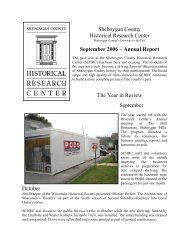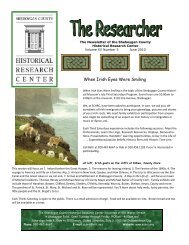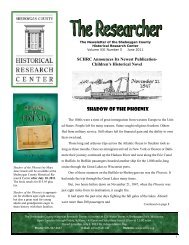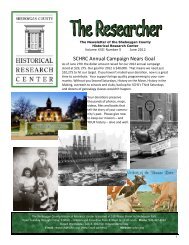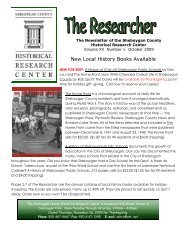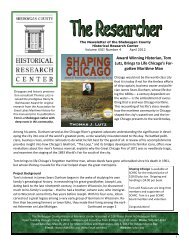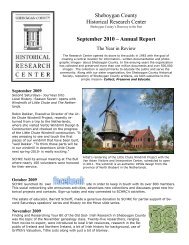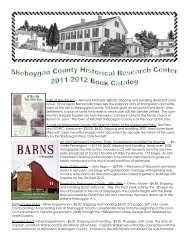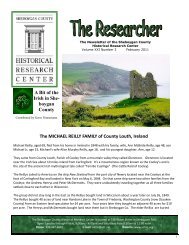October 2010 - Sheboygan County Historical Research Center
October 2010 - Sheboygan County Historical Research Center
October 2010 - Sheboygan County Historical Research Center
Create successful ePaper yourself
Turn your PDF publications into a flip-book with our unique Google optimized e-Paper software.
Oral Histories: Wisconsin Survivors of the HolocaustTaken from www.wisconsinhistory.orgSix million European Jews were systematically murdered by the Nazis and their allies during the1930s and 1940s. This persecution of Jews is known as the Holocaust. As Nazi tyranny spread, millionsof other people were also killed by the Third Reich. About 140,000 Holocaust survivors came tothe U.S. More than 1,000 eventually settled in Wisconsin.Wisconsin <strong>Historical</strong> Society archivists interviewed 22 Holocaust survivors and two American witnessesbetween 1974 and 1981. These oral histories are now available digitally and in their entirety forthe first time, uncensored and unfiltered. (www.wisconsinhistory.org) Three short vignettes follow.Lucy Rothstein Baras was born in Skalat, Poland (Ukraine), on August 15, 1913. She was the oldestchild in the family of an Orthodox Jewish leather merchant. After graduating from high school, she attended law school inLwow. A 1933 law prohibiting Jews from practicing law forced her to abandon her schooling. Instead, Lucy learned the tailoringtrade and returned to Skalat to open her own shop.The Jews of Skalat lived in relative safety until July 4, 1941, when Nazi forces overran the city. They killed about 400 men, includingher father. The Rothstein family continued to survive by working for the Germans in the family leather shop makingshoes for concentration camp workers. A short time later a Jewish ghetto was established in the family's neighborhood in Skalat.Its borders continued to shrink following numerous "actions" in which thousands were murdered.In early 1943 the family was forced to leave their home and work at the labor camp established in Skalat. Lucy was appointedthe personal tailor to the Nazi overseer of the county. Lucy's husband-to-be, Edward Baras, was the overseer's farm administrator.In the summer of 1943, Lucy, her mother, and her brother escaped to the forest, where they hid for three weeks. Duringthat time, her mother failed to return while searching for food. She was never seen again. Lucy and her brother joined a groupof Jews hiding deeper in the woods. They remained there until their liberation by the Russian army at the end of 1943. Afterliberation, they traveled through Zbaraz, eventually to return to Skalat in early 1944 where she immediately reunited with Edward.The two were wed and a son was born in 1945.Fearing similar persecution under the communist regime, Lucy and her family fled the Ukraine soon after their son was born.They were captured in Czechoslovakia, but escaped to a displaced persons camp at Bamberg, Germany, where they were interreduntil 1950. After leaving Germany, the Baras' spent nine months in New York before arriving in <strong>Sheboygan</strong>, Wisconsin.They joined Edward Baras' brother and sister, who were relocated to <strong>Sheboygan</strong> directly from Germany. Edward worked as amachinist at the Kohler Company until his retirement in 1974. Lucy worked as a part-time tailor for many years. She died in February2002.Rothstein Home, 1925 Baras Family, 1949Survivors Rothstein Baras Family 1949Other Local Resources- <strong>Sheboygan</strong>’s own Mead Public Library established a Jewish Holocaust Collection in 2001for consultation and use by the public. It is located in the Fela and Anschel Warschau Room. The purpose of the collection is tocollect and make available for researchers materials about the Holocaust contributed from the personal collections and files of<strong>Sheboygan</strong> residents who survived the Holocaust and its aftermath. Generous support from community members enabled theLibrary to introduce the collection with 150 cataloged items along with numerous documents and photographs, some of whichare displayed in the Warschau Room. Donors are listed in a commemorative booklet available at Mead Library.4



